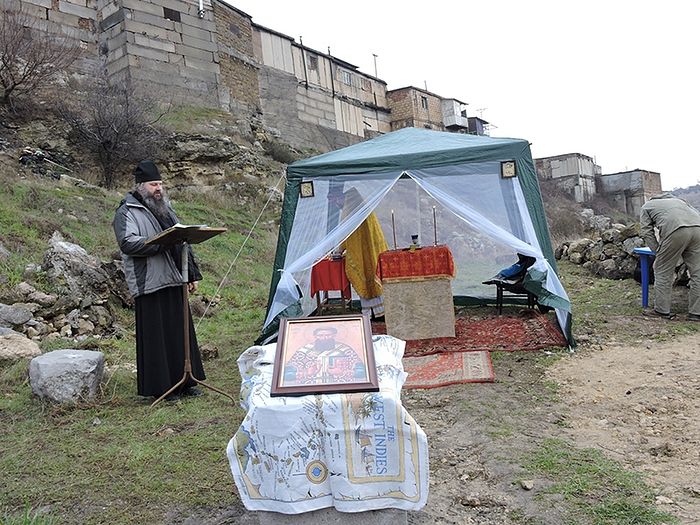
First Liturgy in 500 years celebrated near Crimean cave church
Orthochristian – 11/3/18
On the second Sunday of Great Lent, the Divine Liturgy was celebrated at the site of an ancient Crimean cave monastery for the first time in 500 years, reports the Diocese of Simferopol and Crimea.
The cave monastery, located in the center of the Heraclean Peninsula, functioned from the middle of the 13th century until the middle of the 15th century.
The Divine Liturgy was celebrated by the community named in honor of St. Gregory Palamas, formed with the blessing of His Eminence Metropolitan Lazarus of Simferopol and Crimea in 2016. The community is pastored by Fr. Alexander Leonov of the nearby Church of the Reigning Icon of the Mother of God.
The community of St. Gregory decided to celebrate their patronal feast at the site of their future church at SarandinakinaBalka, near a cave church which was part of the ancient cave monastery complex. It was decided not to serve in the cave church itself, as rock debris periodically falls from its vaults, but in a tent church erected nearby. A portable altar was erected inside the tent-church. An antimens with relics of the holy Royal Martyrs was provided by the Archpriest Alexei Petrenko of the Cathedral of the Royal Passion-Bearers on Red Hill, and the Eucharistic set was donated by a group of faithful.
The service passed without rain, despite the forecast. All communed of the Holy Mysteries and the mood was joyful and blissful. As soon as Fr. Alexander said the dismissal, the wind picked up and it began to rain.
***
The monastery cave complex is located on the outskirts of Byzantine Cherson. It was cut down into the steep rocky slopes of SarandinakinaBalka, and consisted of three blocks: liturgical, burial-memorial, and economic. The liturgical block is represented by the church.
The funeral-memorial unit included seven ossuaries, underground burials, and a room for the funeral service. The economic complex consisted of a large basement, a winery, a refectory, and a kitchen. The monks’ labor mainly focused on their urgent needs. They produced wine from the grapes that grew on the slopes.
Judging by ceramics found on site, the monastery seems to have been in use from the mid-13th to mid-15th centuries.
The internal organization of the monastic community has all the signs of a lavra: a single center, including a church, refectory, kitchen, basement with a cistern, a winery, and a free-standing cave-hesychasterion. The hesychast way of life was popular in 14th-century Chersonese monasticism due to the victory of Palamite theology in the Orthodox Church and the penetration of the hesychastic ideal into Cherson.


